View in other NatureServe Network Field Guides
NatureServe
Montana
Utah
Wyoming
Idaho
Wisconsin
British Columbia
South Carolina
Yukon
California
New York
Western Swordfern - Polystichum munitum
Native Species
Global Rank:
G5
State Rank:
S3S4
(see State Rank Reason below)
C-value:
9
Agency Status
USFWS:
USFS:
BLM:
External Links
State Rank Reason (see State Rank above)
Polystichum munitum occurs in west-northwest Montana in moist forests where many observations have found it to be common and tolerant of many disturbances. Montana populations are on the eastern edge of its range.
- Details on Status Ranking and Review
Range Extent
ScoreE - 5,000-20,000 sq km (~2,000-8,000 sq mi)
Area of Occupancy
ScoreD - 6-25 4-km2 grid cells
Number of Populations
ScoreC - 21 - 80
Number of Occurrences or Percent Area with Good Viability / Ecological Integrity
ScoreB - Very few (1-3) occurrences with excellent or good viability or ecological integrity
Environmental Specificity
ScoreC - Moderate. Generalist or community with some key requirements scarce
Long-term Trend
ScoreU - Unknown
Trends
ScoreU - Unknown
Threats
ScoreD - Low
CommentThreat categories include: Housing & urban areas, Logging & wood harvesting.
Intrinsic Vulnerability
ScoreC - Not intrinsically vulnerable
General Description
Plants: Coarse evergreen perennials from scaly, short-creeping, almost vertical rhizomes (Lesica 2012).
Leaves: Clustered, monomorphic (all basically the same size and shape), arching, 30–120 cm long (Lesica 2012), 5-25 cm wide (Douglas et al. 2000); leaf blades once-pinnate, narrowly lanceolate; petiole about ¼ of the leaf length, scaly; pinnae alternate, about 35-70 pairs (McGregor et al. 1986), not overlapping, narrowly lanceolate to linear with a shallow lobe projecting from one side of the asymmetric base, 2–8 cm long with minutely toothed, erect-spiny margins (Lesica 2012); rachis and costa (vein of pinna) with 2 forms of scales (Hitchcock et al. 1969), some scales being >1 mm in width and others almost hairlike (Douglas et al. 2000).
(Lesica’s contribution adapted from
Lesica et al. 2012. Manual of Montana Vascular Plants. BRIT Press. Fort Worth, TX)
Phenology
June-September (McGregor et al. 1986).
Species Range
Montana Range
Range Descriptions
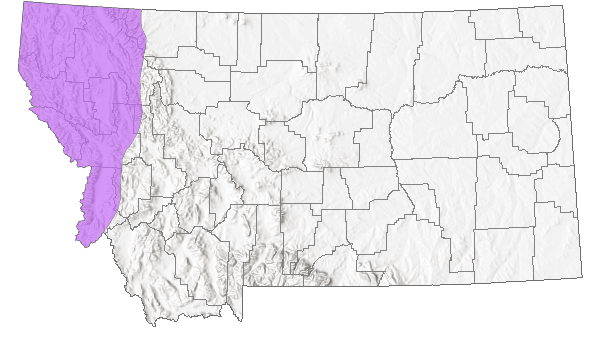
 Native
Native
Range Comments
Northern 2/3 of CA, extending northward into s 2/3 of w BC, crossing s BC and extending into n 2/3 of ID and w MT (FNA 1993). In Montana, from Lincoln and Flathead south to Ravalli Counties (Lesica 2012).
(Lesica’s contribution adapted from Lesica et al. 2012. Manual of Montana Vascular Plants. BRIT Press. Fort Worth, TX)
Observations in Montana Natural Heritage Program Database
Number of Observations: 79
(Click on the following maps and charts to see full sized version)
Map Help and Descriptions
Relative Density
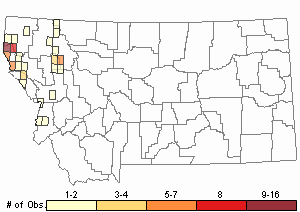
Recency
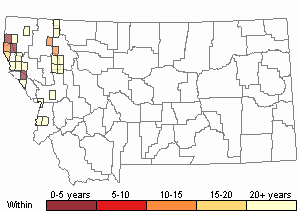
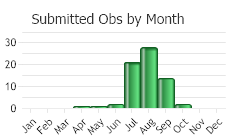
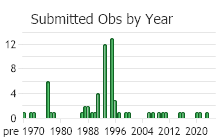
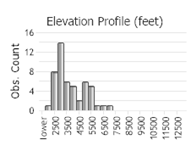 (Observations spanning multiple months or years are excluded from time charts)
(Observations spanning multiple months or years are excluded from time charts)
Habitat
Terrestrial, growing in soil, seldom on rocks (FNA 1993); shady banks with rich, damp soil (McGregor et al. 1986), moist forest, often with
Thuja plicata; valleys to montane (Lesica 2012).
(Lesica’s contribution from
Lesica et al. 2012. Manual of Montana Vascular Plants. BRIT Press. Fort Worth, TX)
Ecology
The pinnae are planar when the plants grow in shade. They are contorted in plants receiving more sun (FNA 1993).
Reproductive Characteristics
Sori and Indusia: Sori (clusters of sporangia) round (Douglas et al. 2000), growing on both sides of midvein in 1 or 2 rows on bottom side of fertile pinna. Indusium has fringed margins and is attached at the center of the sorus, umbrella-like (Lesica 2012).
(Lesica’s contribution adapted from
Lesica et al. 2012. Manual of Montana Vascular Plants. BRIT Press. Fort Worth, TX)
Management
The plants, mostly wild-collected, are popular for landscaping, and the fronds are used extensively in floral arrangements (FNA 1993).
Stewardship Responsibility
References
- Literature Cited AboveLegend:
 View Online Publication
View Online Publication Douglas, G.W., D. Meidinger, and J. Pojar, editors. 2000. The Illustrated Flora of British Columbia. Volume 5. Dicotyledons (Salicaceae through Zygophyllaceae) and Pteridophytes. British Columbia Ministry of Environment, Lands and Parks and British Columbia Ministry of Forests, Victoria.
Douglas, G.W., D. Meidinger, and J. Pojar, editors. 2000. The Illustrated Flora of British Columbia. Volume 5. Dicotyledons (Salicaceae through Zygophyllaceae) and Pteridophytes. British Columbia Ministry of Environment, Lands and Parks and British Columbia Ministry of Forests, Victoria. Flora of North America Editorial Committee, eds. 1993. Flora of North America North of Mexico. Volume 2. Pteridophytes and Gymnosperms. Oxford University Press, Inc., NY. xvi + 475 pp.
Flora of North America Editorial Committee, eds. 1993. Flora of North America North of Mexico. Volume 2. Pteridophytes and Gymnosperms. Oxford University Press, Inc., NY. xvi + 475 pp. Hitchcock, C. L., A. Cronquist, M. Ownbey, and J. W. Thompson. 1969. Vascular Plants of the Pacific Northwest. Part I: Vascular Cryptogams, Gymnosperms and Monocotyledons. Seattle, WA: University of Washington Press. 914 pp.
Hitchcock, C. L., A. Cronquist, M. Ownbey, and J. W. Thompson. 1969. Vascular Plants of the Pacific Northwest. Part I: Vascular Cryptogams, Gymnosperms and Monocotyledons. Seattle, WA: University of Washington Press. 914 pp. Lesica, P., M.T. Lavin, and P.F. Stickney. 2012. Manual of Montana Vascular Plants. Fort Worth, TX: BRIT Press. viii + 771 p.
Lesica, P., M.T. Lavin, and P.F. Stickney. 2012. Manual of Montana Vascular Plants. Fort Worth, TX: BRIT Press. viii + 771 p. McGregor, R.L. (coordinator), T.M. Barkley, R.E. Brooks, and E.K. Schofield (eds). 1986. Flora of the Great Plains: Great Plains Flora Association. Lawrence, KS: Univ. Press Kansas. 1392 pp.
McGregor, R.L. (coordinator), T.M. Barkley, R.E. Brooks, and E.K. Schofield (eds). 1986. Flora of the Great Plains: Great Plains Flora Association. Lawrence, KS: Univ. Press Kansas. 1392 pp.
- Additional ReferencesLegend:
 View Online Publication
View Online Publication
Do you know of a citation we're missing? Lesica, P., M.T. Lavin, and P.F. Stickney. 2022. Manual of Montana Vascular Plants, Second Edition. Fort Worth, TX: BRIT Press. viii + 779 p.
Lesica, P., M.T. Lavin, and P.F. Stickney. 2022. Manual of Montana Vascular Plants, Second Edition. Fort Worth, TX: BRIT Press. viii + 779 p.
- Web Search Engines for Articles on "Western Swordfern"





